21.12.2014
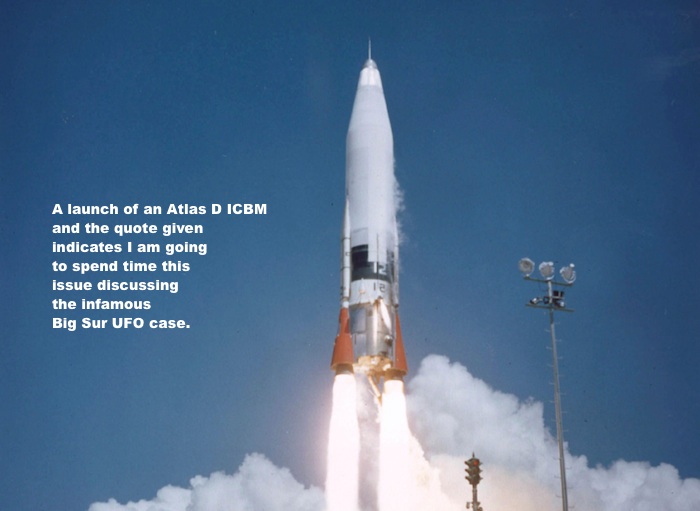
Jacob’s conjectures may mystify and amuse many and even seem persuasive to those without an appropriate background. That , plus the fact that the physical evidence is long since gone, is likely why myths continue to surround and degrade the historical sig- nificance of the Big Sur adventure.
Kingston George - Buzzing Bee missile mythology flies again
.
Joel Carpenter and the Big Sure case
In May of 2009, Joel Carpenter had contacted me about the Big Sur case and exchanged with me a few ideas he had about it. Ini- tially, we discussed possible astronomical solutions where an astronomical object may have entered the field of view but quickly determined all were untenable. Over the next few days, he bounced some ideas back and forth with me but gave little indication what he was about to reveal. Then he sent me a document that was very pertinent to investigating the case. While Robert Hastings, Robert Jacobs, and Kingston George had all cited the 13 October 1964 preliminary report in their articles, nobody had been able to produce the final report, which might have more information on the subject. I was shocked when Joel e-mailed me a copy with the request to keep the information confidential. My first question was if he had contacted Kingston George about it. He confirmed that he had done so and George had told him that he thought the document had been destroyed. Not only did this document have selected frames from the “Buzzing Bee” launch, it also mentioned how well the telescope performed for the “Butterfly Net” launch of September 15th, which is supposed to be the launch that was interfered with by the UFO.
By September of 2009, Joel Carpenter had acquired another document that might help resolve the Big Sur UFO case. The e-mail had the interesting title of “CONFIDENTIAL PLEASE Big Sur: Toast”. The document enclosed was a report for Nike-X operations at Kwaja- lein atoll for the month of September 1964. It specifically mentioned how well the radar systems tracked incoming re-entry vehicles from the two Atlas launches in question. Needless to say, I was excited about Joel’s findings and asked him when he planned on publishing his work. His answer was “soon”. I patiently waited and held my tongue hoping that the work would be complete within a reasonable amount of time. Joel would occasionally e-mail me with bits and pieces he had done for his work but it seemed that he was never completely finished. Mr. Carpenter was a pretty thorough individual and it appeared that he was just trying to make sure he had all the bases covered on this one.
Joel Carpenter implied that it was originally a collaborative effort between he and one or more researcher(s) and that he hoped to publish it in the International UFO reporter (IUR). Over the years, that collaboration between he and other researchers seemed to wane and Joel was apparently left trying to complete the work on his own. In May of 2010, he confided to me that he had reserva- tions about publishing a work that could paint Robert Jacobs as a dishonest individual and feared it may result in a lawsuit of some kind. It is too bad that the arrogance of Jacobs was so great that it may have intimidated Carpenter to the point that he never fin- ished his work. In an apparent attempt to get Robert Hastings to change his tune, Joel told me that he had contacted him with the information he had obtained. I was also under the impression that he had shared some of the documents with Hastings. According to Mr. Carpenter, Hastings’response was composed of“abuse and bluster”. If this is true, it appears that Hastings was not interested in the facts but was more interested in continuing to promote the story as told by Jacobs.
It is too bad that Mr. Carpenter did not complete his work and I feel somewhat reluctant in presenting HIS research in MY words. However, if I did not do it, I am not sure if anyone else would. Joel failed to publish because he never completed the work or others influenced him not to be hasty about it. What I hope to present here is much of what he shared with me and add additional infor- mation that I had discovered.
.
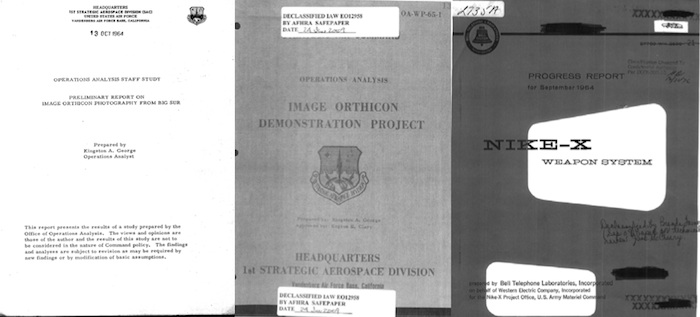
Three documents that tell the real story about the Big Sur Atlas missile launches in September 1964. The first is the Preliminary report on the Image Orthicon Photograph from Big Sur by Kingston George. This docu- ment has been mentioned by George, Jacobs, and Hastings in their articles. The other two documents were not seen/mentioned by these authors. Joel Carpenter and his associates acquired these documents, which help clear the air on the case. The Operational Analysis of the Image Orthicon Demonstration Project by Kingston George is a more extensive report than the preliminary report and includes details about the launches including actual frames from the “Buzzing Bee” film. The Nike-X progress report for September 1964 presents information about how well the Atlas “D” missiles and payloads were tracked by the Nike-X radar systems from Kwajalein atoll.
.
THE BIG SUR UFO INCIDENT SAGA

The Big Sur UFO incident has become part of the UFO case book for over three decades. The evolution of the story and the argu- ments against it over the years is something the reader should be aware of before elaborating on other details that affect the case.
All aboard the SS Jacobs
The story was first revealed to the public by Robert Jacobs in the October 12, 1982 National Enquirer. This brief article was reproduced in Flying Saucer Review in Octo- ber of 1983. According to that article, Jacobs states the missile, an Atlas F launched on January 8, 1965, was shot down by a UFO when it was at an altitude of 60 miles:
Suddenly we saw a UFO swim into the picture. It was very distinct and clear, a round object. It flew right up to our missile and emitted a vivid flash of light. Then it altered course and hovered briefly over our missile...and then there came a second vivid flash of light. Then the UFO flew around the missile twice and set off two more flashes from different angles and then it vanished. A few second later, our missile was malfunctioning and tumbling out of control into the Pacific Ocean, hundreds of miles short of its scheduled target....The film was turned over to the two men in plain clothes from Washington, who I believe were CIA agents. The film hasn’t been heard of since. 1
The next version of the story appeared in the January 1985 issue of Omni Magazine. Eric Mishara managed to contact Florenz Mansmann, Jacob’s superior officer, who con- firmed the story. The date for the event was determined to be September 15, 1964. Mishara also contacted Vandenberg, who responded that the missile launched on that date was not shot down and had hit the target. 2
This story was pursued by T. Scott Crain in the September 1988 MUFON Journal. Like Mishara, he talked to Mansmann, who con- firmed the story told by Jacobs. When Crain discussed the case with Mishara and his source from Vandenberg, Mishara stated it was a Sergeant Lorri Wray from the base Public affairs office. Crain could not contact Wray and Mansmann had issues with this statement about the warhead reaching its target. According to Crain:
Mansmann claims the statements made by the AF spokesman makes no sense. If the Air Force spokesman did review a close-dated launch and saw nothing, it could not have been the launch that perpetuated such quick security action.3
When Crain tried to contact that office, the USAF stated there were no such records of an Atlas F being launched on September 15, 1964. The confusion may have been caused by Jacobs’ claim that it was an Atlas F. The launch on September 15th, was an Atlas D.
Jacob’s second version of the story appeared in the MUFON journal of January 1989. His article took on the title of “Deliberate de- ception”. In that article, there was some revisions performed. The date of the launch was determined to be September 2, 3, or 15, 1964. The missile type was still an Atlas F but Jacobs suggests it might have been a D instead. He added that this test was designed to defeat radar detection. According to Jacobs, the rocket was huge in the filming and the lower third of the rocket filled the field of view. Jacobs also pointed out that at T+400 seconds (well after re-entry vehicle separation from the main booster), the nose cone
was still being tracked. At this point, nobody noticed anything unusual. It was not until the film was reviewed by Mansmann that the UFO event was seen:
Another object flew into the frame from left to right. It approached the warhead package and maneuvered around it. That is, this ... “thing”...flew a relative polar orbit around our warhead package which was itself heading toward the South Pacific at some 18 thousand miles an hour!
As the new object circumnavigated our hardware, it emitted four distinct bright flashes of light at approximately the 4 cardinal compass points of its orbit. These flashes were so intense that each “strike” caused the I.O. tube to “boom” or form a halo around the spot. Following this remarkable aerial display the object departed the frame in the same direction from which it had come. The shape of the object was that of a classic “flying saucer.” In the middle of the top half of the object was a dome. From that dome, or just beneath it, seemed to issue a beam of light or which caused the flashes described.
Subsequently the warhead malfunctioned and tumbled out of suborbit hundreds of miles short of its target. This ... unidentified flying ... “thing” had apparently “shot down” an American dummy atomic warhead!4
Jacobs then went on to hypothesize why the telescope was present for this important event.
(5) Most probably the B.U. Telescope was brought out to California specifically to photograph this event which had been prearranged. That is, we had been setup to record an event which someone in our Government knew was going to happen in advance.
(6) What we photographed that day was the first terrestrial demonstration of what has come to be called S.D.I. or “Star Wars.” The dem- onstration was put on for our benefit for some reason by extraterrestrials. It is this aspect of the event, not merely the recording of another “flying Saucer” which caused such consternation both on the part of Major Mansmann when he told me “it never happened” and on behalf of the government in its two and one half decade coverup of the event and the record we made of it.5
As proof that something out of the ordinary occurred, Jacobs presented a document with the title of “Preliminary report on image orthicon photography from Big Sur”, which was written by Kingston George in October of 1964:
In this document, “King” George gives us a quick sketch of the whole Big Sur project, tells us that “Over the period of 30 days, from 31 August to 30 September, during which the Boston University telescope was ready to film launches, eleven flights were made from Vanden- berg,” that “a final report will be forthcoming in a few weeks with a complete description of the system and the operations over the past several weeks,” that “a documentary film of about 30 minutes length containing several minutes of selected film clips will be assembled” and that one powered flight anomaly was observed (italics mine), and the coverage of the flights has produced enough data to show that Big Sur photography could be an important adjunct to other instrumentation.”
It is not clear whether or not Kingston George was privy to the screenings of the Big Sur film which recorded the UFO. My suspicion is that he was one of those to whom Mansmann has admitted showing the film. His document, however, states clearly that a missile malfunc- tioned during the B.U. test period, now putting the final lie to the Air Force denials.6
This is how the case stood for five years, until Kingston George decided to enter the UFOlogical fray.
The ship springs a leak
In 1993, Kingston George responded with an article for Skeptical Inquirer, which presented a different version of events than what Jacobs described. According to George, the rocket launch that Jacobs was referring to was called “Buzzing Bee” and was filmed on September 22nd. This event involved an Atlas D that was the only launch of all the test flights that showed all the events that Jacobs and Mansmann described because of the time of day it was recorded. George recalls that the B. U. telescope recorded something unique but it was not a UFO. It had been able to record the decoy package deployment that was traveling in the trajectory with the actual test warhead. Most importantly, the film showed that one could tell the difference between the decoys and the actual Re- entry vehicle. Kingston George revealed that this prompted security regulations to be enforced on the film since what it recorded was classified.
Omitting the technical details, what had happened on Buzzing Bee was that two decoys were fired off by small rocket charges on sched- ule, but some of the decoy packing material also tailed along and could be seen optically and also by certain kinds of radar. A little cloud of debris around each decoy warhead clearly gave away the false status, almost as well as coloring the decoys bright red.
This, of course, led to more than a little consternation at SAC Headquarters and in higher military circles. Although correctable by re- design, the alarm in the minds of the strategic analysts was that the Soviets could defeat our ICBM decoys by using a few telescopes on mountain peaks in the USSR and relaying information on which objects were decoys to the Soviet ICBM defense command center. An immediate concern was that, although few understood its significance, a raft of people at Vandenberg AFB had seen the data. Vulner- ability of a major weapons system is normally classified Top Secret. How could this matter be kept from leaking out?...
As might be expected, the military reaction came swiftly. Everyone who was at the telescope site or had seen the film had to be identified. All, including Jacobs and myself, had to be questioned on what they had seen and what they thought it meant. Each was cautioned not to mention what was on the film to anyone and not to discuss it with others -- even fellow workers who had originally seen it at the same time! None of us had more than a guess at the meaning, and the civilian intelligence experts who did the “debriefing” gave no hints.
Weeks later, my clearance level was increased to allow me to see the films again and analyze them. I don’t think Bob Jacobs ever gainedt he required clearance. The people later assigned to operate the equipment and carry the films around were subsequently cleared to the required level. The Top Secret film was marked for downgrading and declassification after 12 years, but its utility was over after a few months. Top Secret storage is too difficult and expensive for keeping items of dubious worth, and the film and related materials were all destroyed long before the 12 years were up.7
As for Jacobs’ claim that the event was all prearranged for the B.U. telescope to be there so it could witness this event of an alien interfering with a dummy warhead, Kingston George found it very unlikely. He recalled that it took a lot of effort to get the scope there in the first place and there seemed to be little cooperation/help to accomplish the task:
My supervisor at the time, Gene Clary, and I would have been thrilled to have had any kind of support from anywhere in the Government! The truth is, getting permission to use the national forest site, arranging air and ground transportation, finding $50,000 to pay the air freight, and attending to myriad other physical and monetary obstacles, took us the better part of nine months.8
On a final note, Kingston George pointed out that there was no UFO and the mission was a success with no loss of a re-entry ve- hicle.
Trying to plug the holes
By 2007, Robert Hastings stepped into the arena as he attempted to promote his book about UFOs and nuclear weapons. He wrote an arti- cle for the International UFO Reporter with the title, “A shot across the bow: Another look at the Big Sur incident”. In that article, Hastings presented letters that Florenz Mansmann and Robert Jacobs wrote about the inci- dent in the 1980s as critical evidence to support Jacobs’ version of events. He also criticized Kingston George for misquoting Jacobs on several small items and then argued that the B. U. Telescope should have been able to resolve the UFO. He also quotes Jacobs as stating:
I recently asked Jacobs to elaborate upon his earlier published comments relating to the number and type of objects visible in the field of view just before and during the shoot-down event. He responded, “We saw the nose cone separate and open up—it looked like an alligator’s open jaws. We saw the experiment, which was metallic chaff, come out. We saw the dummy warhead come out and inject into a different [trajectory]. All of the other components, the chaff and so on, were all still flying along. They don’t lose altitude all that quickly because of momentum. So, there were several ob- jects visible when the UFO came into view.9
Hastings then revealed that there was an Atlas D launched on the 15th
and Jacobs agreed that this was the launch he recalled because of the time of day. Jacobs also denied being present at the telescope on the 22nd because his personal log states he was not there on that date. However, by his own words, he never saw the UFO event until he saw the film with Mansmann in the screening room. He did not have to be present at the telescope on the day the film was shot to have seen the UFO footage.
The fact that the 15th launched mentioned a Low Observable Re-entry Vehicle was what convinced Jacobs that the 15th was the Atlas that he remembers was shot down by the UFO:
Jacobs’s response was emphatic, “No, we were testing the RV itself. It was not a target test.” He then elaborated, “There were several inter- esting aspects of the anti-missile missile tests. This particular one involved a dummy warhead and a bunch of radar-deflecting aluminum chaff. The dummy warhead was targeted to splashdown at Eniwetok Lagoon. . . . As far as I know Kwajalein [played no part in this test] aside from radar tracking. There was no planned Nike launch [involved with it].”21
Given this unequivocal statement, the question remains: Did George select and discuss the same missile test described by both Jacobs and Mansmann? The entries in Jacobs’s original mission log, as well as the now-available data published by Encyclopedia Astronautica, appear to indicate that he did not, thus negating much of the force of George’s critique.10
One thing missing from this article is the presentation of Jacobs’“Original mission log” (sometimes referred to as a personal log). If Jacobs had an “Original mission log” in his possession, why didn’t he know the date of the UFO event and originally thought that it occurred in 1965? Its omission from the evidence presented indicates (assuming it actually exists) that nothing of importance was in this document. Despite being unable to prove that the 15th was the launch in question, Hastings then proceeded to go into a conspiracy rant, where he chose to imply that Kendrick Frazier, Philip Klass, and Kingston George were all part of the cover-up.
The decks are awash
Kingston George would respond with another Skeptical Inquirer article in 2009 with the title of “Buzzing Bee mythology flies again”. In that article, George describes how the B. U. Telescope really had difficulty resolving details at the time of the warhead RV and decoys being released. The tank from the rocket was reflecting light and was a large blob while the RV and decoys were essentially
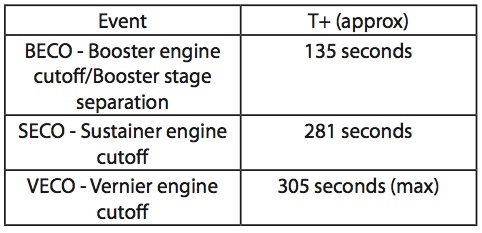
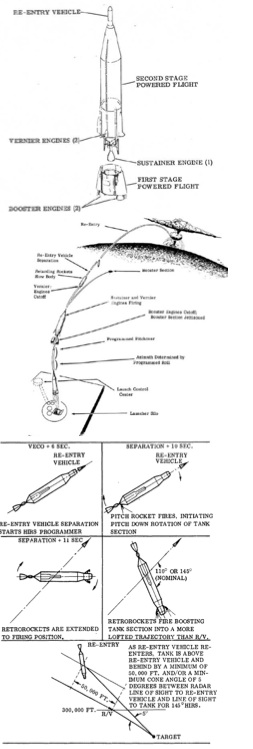
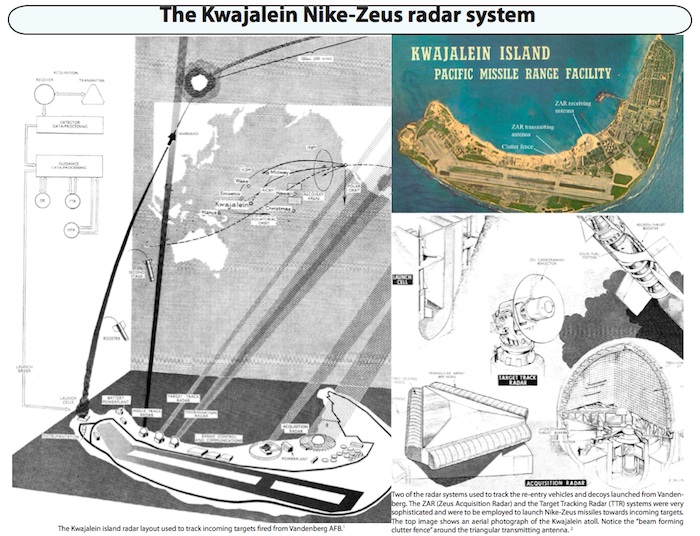
specks of light. More importantly, Mr. George restated that, in his professional opinion, the lighting conditions for “Butterfly Net”, (the launch of the Atlas D on the 15th of September) were not favorable for tracking after the engines cutoff because the tracking operators would be unable to see the reflection of the rocket body/re-entry vehicle against the daylight sky:
Butterfly Net was launched in the morning, long after sunrise, with a bright sky behind it. The image orthicon would have been adjusted for daylight. The manual trackers were handicapped after engine shutdown, when the vapor trail of engine fuel was depleted some 240 seconds after lift-off. Their inferior spotting scopes would not permit direct viewing for more than a few seconds.11
Unlike “Butterfly Net”, “Buzzing Bee” was launched before sunrise and one could still track the targets because of the contrast be- tween the rocket body reflecting sunlight and the dark sky. If this is correct, then “Buzzing Bee” was the only Atlas launch that could have been tracked after engine cutoff and shown the deployment of the re-entry vehicle as Jacobs and Mansmann described.
Abandon ship?
All of these articles about the Big Sur evidence are available on line if one knows where to look. As I have written previously, there appears to be four potential scenarios surrounding the story as told:
• The events are as Kingston George described and Mansmann/Jacobs confused the events over the years being influenced by their belief in alien visitation.
• Jacobs and Mansmann lied about the event occurring as they described.
• Some other test was being performed on one of the launches in September 1964 that was misinterpreted by Jacobs and Mans- mann as an alien spaceship interfering with the warhead.
• Jacobs and Mansmann are telling the truth concerning what happened that September, have accurately recalled the event, and there is a massive cover-up by the US government (Kingston George and CSI being part of it) to hide the fact that aliens interfered with an Intercontinental Ballistic Missile test.
Since we have no evidence, other than anecdotal claims, that the incident involved an alien spaceship, it appears this is one of the least likely scenarios. Meanwhile, the anecdotal account given by Kingston George required no alien spaceships or conspiracies. His story presents a perfectly reasonable explanation making it a more plausible scenario. Which scenario is the most correct would require more evidence than what has been presented to date.
Notes and References
1. Jacobs, Robert. “How a UFO destroyed an American rocket. Former U.S. Air Force officer’s revelation: The truth is too important to hide any longer. UFO spied on a space missile launch and I filmed it.” Flying Saucer Review. October 1983. P. 24.
2. Mishara, Eric. “UFO Cover-up?”. Omni magazine. January 1985. P. 87
3. Crain, T. Scott. “UFO Filmed Circling Atlas Rocket”. MUFON UFO Journal. No. 245, September 1988. P. 11
4. Jacobs, Bob. “Deliberate Deception: The Big Sur UFO filming”. MUFON UFO Journal, No. 249, January 1989. P. 6.
5. ibid. P. 7
6. ibid. P. 8
7. George. Kingston A. “The Big Sur ‘UFO’: An Identified Flying Object”. Skeptical Inquirer. Winter 1993. P. 187.
8. ibid. P. 186.
9. Hastings, Robert. “A shot across the bow: Another look at the Big Sur incident”. International UFO reporter. P. 10-11
10. ibid. P. 21
11. George. Kingston A. “Buzzing Bee mythology flies again”. Skeptical Inquirer. January/February 2009. P. 45.
.
The Florenz Mansmann factor
One item that is used to verify the claims of Jacobs are the letters of Florenz Mansmann, who was part of the analysis team asso- ciated with the films. Shortly after Jacobs wrote his story, UFO investigators contacted Florenz Mansmann hoping to have him confirm the story. Mansmann did so in several letters that Robert Hastings shared with me several years ago in an effort to convince me, and other skeptics, that Jacobs story was authentic.
Some of the highlights from his January 30, 1983 letter to Lee Graham1 were:
• The Enquirer story was true except the year was 1964 and not 1965.
• The camera system was capable of “nuts and bolts” imaging from a distance of 70 miles.
• He was concerned about information vital to humanity falling into the wrong hands.
• He hypothesized that there might be a super secret scientific study sending up these rockets to communicate with extrater- restrials. He concluded that two way communication will come soon.
• He also suggested that the United States has probably been selected by ET to be contacted because it is interested in bettering mankind and not destroying it.
This was followed by a March 3, 1983 response to Lee Graham answering questions he was asked.2 The key points were:
• He did not know when Lookout Mountain analyzed the film because the film “was rushed east on a special aircraft when we
released it.”
• To his best recollection, it was the last Atlas launch from Vandenberg.
• General Wells was his commanding general.
Mansmann also responded to researcher Peter Bons on March 8, 1983, answering his questions.3 Some of the important items men- tioned were:
• Bob (Jacobs) had opened a “pandora’s box” with his story, which resulted him being bombarded with letters and requests.
• The Enquirer story was true except the year was wrong and it was in 1964.
• The assumption at the time was the object was extraterrestrial based on what was seen on the film.
• Based on his memory, “the shape was classic disc, the center seemed to be a raised bubble, not sure if any ports or slits could be seen but was stationary, or moving slightly-floating-over the entire lower saucer shape which was glowing and “seemed” to be rotating slowly. At the point of beam release-if it was a beam, it, the object, turned like an object required to be in a position to fire from a plat- form....but again this could be my own assumption from being in actual combat.”
• Harvard University’s computer scanning of data for Extraterrestrial signals might shed light on this case. Four years later, on May 6, 1987, Mansmann communicated with Scott T. Crain4. He had told Crain the following:
• Bob Jacobs saw the film twice. Once in the film quality control room and once in the showing, which the CIA attended.
• He saw the film four times. Once in the film quality control. Once in the viewing for the General and one of his staff. Once in the viewing for the chief scientist and his assistant. The last involved Jacobs, the Chief Scientist and his assistant, the three govern- ment men, and Bob Jacobs.
• He ordered Bob Jacobs not to discuss the launch with anyone because of the nature of the launch, the failure of the launch, and that the film “showed an interference with normal launch patterns”.
• The object was saucer shaped but he was not sure if there was a dome.
• He did not know the names of the CIA personnel.
• He released the film to the Chief Scientist.
• He was ordered not to discuss the film.
• The stories told by he and Jacobs were factual.
• The response by Vandenberg that the missile performed normally and hit the target made no sense. If such records did exist, then it could not have been the launch he and Jacobs were describing.
• If the government wants to withhold such information, it may be related to the “Star Wars” program and it should be protect- ed.
Finally, Mansmann wrote to Curt Collier of Paramount Pictures5 on November 15, 1995. In that letter, he mentioned:
• The Image Orthicon instrument was capable of photographing “nuts and bolts” and they had to be 70 miles away “just to be in focus”.
• He confirms that Jacobs’ story is correct.
• He only saw the film three times. The final viewing involved the director of the Chief Scientist and his assistant, Two government agents, Bob Jacobs and himself.
These are the only communications by Mansmann that were sent to me by Robert Hastings back in 2008. They do give some insight into Mansmann’s mind set. He was very concerned about mission security associated with the launch and how information from that launch should not fall into the wrong hands. He also seemed to imply he was satisfied that aliens were visiting us and attempt- ing communications. These factors may have influenced Mansmann in his recollections, which we can examine for accuracy.
There were two launches from Vandenberg on September 15, 1964. One was a Minuteman and the other was an Atlas D. So, Mans- mann was correct on this point. However, according to the Astronautix web site, both missiles reached their target, which implies that the USAF was correct when it stated that there was no malfunction. This indicates that his recollections of this being the rocket launch, where an alien spaceship had interfered with the re-entry vehicle is not correct. In order for the Jacobs/Mansmann story to be correct, somebody (i. e. the US government) would have altered the data for the rocket launch so future historians would assume that it performed correctly..
Mansmann also stated it was the last Atlas D launch. It is hard to understand what he meant by this. It obviously was not the last Atlas D launch from Vandenberg because there were many more launched after September 1964. It was not the last Atlas D launched from Vandenberg for 1964 because, in addition to several missile firings in the latter part of 1964, there were others used to launch spy satellites.6 It was also not the last Atlas D launched as part of the BU telescope program. “Buzzing Bee” was launched on the 22nd and there was also an Atlas/Agena (mistakenly recorded in the IO documentation as a Thor/Agena) launched on the 23rd, which had placed a KH-7 satellite into orbit. While this is a simple mistake, it indicates that Mansmann’s memories are not to be considered perfect.
Another claim by Mansmann was the B.U. telescope had to be 70 miles away to get a rocket “in focus”. Perhaps he meant for tracking purposes. The actual choice of the location had more to do with the angle at which the telescope could view the launches. Like all other telescopes, the B.U. telescope probably could focus on objects much closer than 70 miles. Again, this is a simple mistake by Mansmann regarding details he probably was unfamiliar with.
However, the ability to see “nuts and bolts” from 70 miles away is something that needs to be examined. We don’t have any good imagery from the telescope showing this capability. I have no doubt that the actual rocket could be imaged but I am skeptical of the claim that it could see “nuts and bolts” without seeing films shot from this distance with the telescope.
What is important to note about the Mansmann letters is that the only thing they do is confirm that Mansmann remembered the events that occurred the same way Jacobs did. Of course, all of these letters were written AFTER Jacobs published his story and one has to consider the possibility that he was influenced by what Jacobs described in that original article. These letters, while impor- tant to mention and consider, are not positive proof that the story was accurately recalled.
Notes and references
1. Robert Hastings collection of letters involving Florenz Mansmann mailed to author in October 2008.
2. ibid
3. ibid
4. ibid
5. ibid
6. According to the Vandenberg launch log (http://www.spacearchive.info/vafblog.htm) and astronautix web sites (http://www. astronautix.com/chrono/1964.htm), there were several Atlas D ICBM launches after “Butterfly net”. Buzzing Bee (Sept 22) Brook trout (Dec 1) Opera glass (Dec 4). There were also other launches in late 1964 that involved an Atlas D or F rocket. Four were Atlas/Agena D’s placing KH-7 spy satellites into orbit (Sept 23, Oct 8, Oct 23, and Dec 4) and one was an Atlas F ICBM launch on Dec 22.
.
The Atlas D launch and trajectory
Before examining the documentation, the reader will need to familiarize themselves with some of the events that transpired dur- ing an Atlas D Intercontinental Ballistic Missile (ICBM) launch. Many people are familiar with the Atlas because of its use during the Mercury space program. However, prior to Mercury, the Atlas was designed to be an ICBM that would deliver nuclear warheads to targets over 7,000 miles away. It was an interesting design which was often described
as a one and half stage rocket.
The rocket was centered around a large tank where all the liquid fuel was present.1 At the base of the tank was a rocket motor identified as the “sustainer engine”. Surround- ing the base of this stage was a booster assembly with two additional Booster engines. The purpose of this design was to have all the engines firing at launch. Once the boost phase was over, the booster engines were shutdown and booster assembly stage was jettisoned. However, the sustainer engine continued firing. Attached to the sides of the rocket were two Vernier engines used for attitude control. The continued to operate after the sustainer engine was shutdown. The image to the right shows this sequence of events except the end of the Vandenberg launches did not have a live warhead as depicted. 2
The approximate time line of events for a standard Atlas launch was as follows3 :

---

About three to six seconds after VECO, the warhead, decoys (if applicable), and any other payloads would separate from what was left of the rocket body/fuel tank. A few seconds after payload separation, the rocket body would fire a series of rocket motors at the top of the rocket tank called the High Impulse Retrorocket system (HIRS).4 The purpose of these retro-rockets was to separate the rocket body from the reentry vehicle so it could be tracked on radar during the reentry phase.
After that, the rocket body and payload(s) traveled on a ballistic trajectory towards the Kwajalein island region of the Pacific Ocean, where a Nike-Zeus radar system was setup to monitor and track the incoming payloads.
-

The Nike-Zeus system, which evolved into Nike-X, was designed to identify and track Intercontinental Ballistic Missile (ICBM) war- heads in order to launch missiles to intercept them. The system never was proven to be a successful Anti-Ballistic Missile (ABM) defense but the Kwajalein Atoll had a fully operating radar system that was one of the most advanced at the time. If any UFOs had interfered with an Atlas missile launch, the Nike-Zeus radars would have been able to detect the effects of such interference.
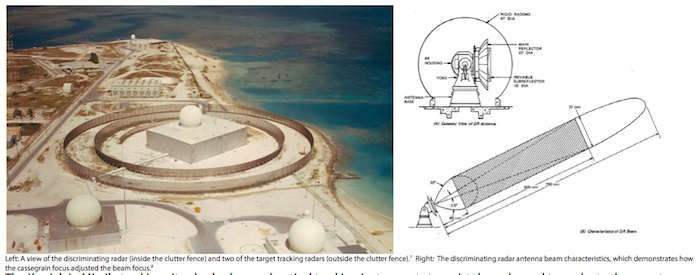



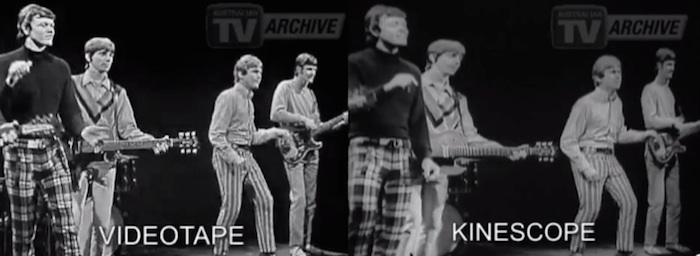
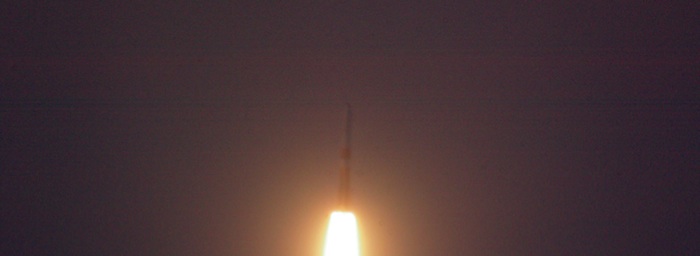
The system was centered around several radars. The Zeus Acquisition Radar (ZAR) was designed to identify the presence of incom- ing targets. The computers took this information to point various radars at the targets. The Discrimination radar (DR) was designed to identify each target and identify the real warhead from any decoys. The target tracking radars (TTR) were supposed to track indi- vidual targets. Finally, the Missile track radars (MTR) were supposed to control the missiles sent up to intercept the targets.
The ZAR was a very interesting design, which was so complex that it had separate transmitting and receiving antennae. The trans- mitting antenna was actually three different transmitters, 120 degrees apart, which revolved at 3.3 RPM. This meant that any given target would have data on it updated every six seconds. The range of the radar was 600nm.3 The receiving antenna was a luneberg lens made up of small plastic foam blocks, impregnated with metal filaments, and a ground plane. These focused returning radio pulses into feeder horns that were on the perimeter of the hemisphere in arcs that were spaced 120 degrees apart. 4
The ZAR transmitting antenna at Kwajalein was surrounded by a fence which was called a “clutter fence” or “beam forming fence”. This fence was designed to prevent radar illumination of nearby ground targets that could interfere with tracking of airborne tar- gets.
The discrimination radar was specifically designed to cover a target area of 22 nm out to a range of 500 nm.5 The antenna used a Cassegrainsystemthatcouldfocusthebeamoverthedesignedtargetareaatanydistance. Thediscriminationradarwassurround- ed by a clutter fence and was positioned close to the target tracking radars. The target tracking radars were also of the Cassegrain focus type. They were able to track targets at a distance of 580 nm if it had a cross section of 0.1m2.6
The final bit of radar equipment was the MTR but, since missiles were not used to intercept targets launched from Vandenberg dur- ing this time period, I see no reason to go into any detail on this system.
.

The Kwajalein Missile tracking site also had several optical tracking instruments to assist the radar and to evaluate the re-entry ve- hicles as they approached the target area. Several of these were mounted on an EC-121K “warning star” aircraft, which was used in the tracking of the payloads launched from Vandenberg. Others were ground based.
This entire array of radar and optical instruments allowed Kwajalein to monitor any missile launches from Vandenberg AFB that were targeted to land in their area. It seems very unlikely that the Kwajalein radar/optical tracking system would have missed any indica- tions of a deviation from the missile’s flight plan.

.

.

A question of resolution
The recording of the rocket launches with the B. U. telescope was a bit different than sim- ply attaching a motion picture camera to the telescope. Instead, an image orthicon tube, designed for use in low light conditions, was used at the scope’s focus. The signal from this tube was then fed, via Coaxial cable, to a monitor into a van. The operator would observe the monitor and adjust the gain of the tube and monitor as necessary to obtain the best images. A 35mm Mitchell motion picture camera was then used to film the monitor display (see image to right).6
This kind of recording system is similar to the old Kinescope recordings used in television be- fore the days of video tape. Kinescope was considered so poor that the Desilu productions refused to use it in their “I love Lucy” broadcasts. Video recording engineer Frederick Remley would write the following about the Kinescope recordings:
Because of the many variables in the combined electronic/photographic process, the quality of
such recordings often leaves much to be desired. Defects often encountered in photographic re-
cording include relatively poor image resolution; a compressed brightness range often limited by
kinescope display technology to a brightness ratio of about 40:1; nonlinearity of recordings, as exemplified by lack of gradation in both the near-white and near-black portions of the reproduced pictures; and excessive image noise due to film grain and video processing artifacts. The final signal-to-noise ratio is often less than 40 dB, especially in the case of 16 mm film.7
One can see the difference between kinescope recordings and video tape recordings in this You tube video (see still images from the video below). 8 After examining this video, it is apparent that the Kinescope system was inferior and caused some loss in resolution.
.

Despite this known problem, it really was the only system the B.U. team could use because the video tape systems at the time did not have the necessary bandwidth.9
This problem with the quality of the film recordings not duplicating what was seen on the monitor was mentioned in the final report for the Image Orthicon project:
The 500 to 1000 lines on an advanced TV system should not in theory be seriously degraded by copying on such film. However, during the demonstration a loss of detail on the film compared to direct viewing of the monitor was experienced, so handling, processing and exposure techniques need further investigation.10
One of the reasons that there was a loss of quality was because they did not use the full resolution of 875 lines in their filming of the images on the monitor because of technical limitations.
The B. U. telescope system uses a fixed 60-cycle vertical sweep with an interlaced 875 line scanning system, each half-scan taking 1/60 second. The motion picture camera actually photographs only one half-scan on the monitor screen, or about 440 lines, as it has been found that the full double scan decreases the resolution on film due to distortion of the electric field on the target between lines on the first scan.11
To add to this resolution issue, the image orthicon tube introduced its own problems. Using an Image Orthicon tube with a 12-inch telescope in the early 1960s, Dr. J. A. Hynek and Justus R. Dunlap noted that their resultant photographs did not quite compare to conventional astronomical photographs when it came to resolving small details:
As yet, the image orthicon has little to offer in high-resolution celestial photography of star clusters and galaxies. The necessity to enlarge the original optical image by projection causes a drastic intensity loss that is barely compensated by the speed of the image orthicon.12
While Hynek and Dunlap were working with low light conditions, they were not exposed to another problem with the Image Orthi- con tube when bright point sources were being recorded. Bright sources of light tended to overload the system and produce dark haloes around them. This effect was called “blooming”. Kingston George noted that “blooming” did occur in the films obtained by the B. U. telescope and that other effects were observed:
The brightest ones would bloom on the closed-circuit TV monitor to form a blob, with size related to brightness, and also leave a persis- tent trail behind as the telescope panned across it. The tracking operators used hand wheels to constantly make tiny adjustments, and the TV screen resembled a pool of vigorous tadpoles.13
One must remember that the purpose of using the Image Orthicon was for recording the events under low light conditions and not exactly for high quality images that could record minute details. Many of the claims about how the B. U. telescope was capable of recording such details are based on mathematical computations that assume ideal conditions. What has been ignored is that the method of recording these events introduced all sorts of issues that reduced the quality of the film.
Despite the limitations of this recording system, the B. U. telescope did prove that it could record enough during the missile’s flight to be useful. It was capable of identifying the major sequence of events and any deviations from normal operations. It could also track the vehicle, under the right conditions, for long distances.
How large would the rocket appear?
In his letters to various researchers, Florenz Mansmann made the claim that the B. U. telescope could photograph “nuts and bolts’ from a distance of 70 miles. This kind of resolution appears to be exaggerated. According to the Image Orthicon final report,
An Atlas missile at a range of 100 nautical miles subtends an angle of about 28 seconds of arc. At 720 inches focal length the length of the missile is portrayed by about 34 lines on a 440 -line TV system. On a ten inch high monitor screen, the image should be about 3/4” long. 14
100 nautical miles (115 miles) is about the distance Buzzing Bee was from Big Sur when BECO occurred.
.

I recently photographed a rocket launch from the Cape of a Delta 4 rocket from a distance of about 9 miles. Using an 800mm lens (32 inch focal length) and a Pentax K110D (6 MP Digital SLR) I took this photograph of the rocket shortly after liftoff. While it is not a duplicate of what one expect of the Image Orthicon imagery, it does show the kind of scale one might expect from the BU telescope in the early part of the launch. The Delta rocket was 2.5 times the size of the Atlas Missile, which means that the Atlas missile would appear the same size using a telephoto with a focal length of 80-inches. Since the B. U. Telescope was a 720-inch focal length, then thedistancetoachievethesamesizeforanAtlasmissilewouldhavebeenabout80miles. ThisislessthanthedistancefromtheBig Sur location to Vandenberg (over 100 miles). In my opinion, something like this image is the best one might expect in the imagery from the B.U. telescope. While the rocket would have been large enough to see, one can hardly call this “nuts and bolts” imaging as Florenz Mansmann described it.
This observation appears to be confirmed by what the Image Orthicon project final report states:
It was pointed out above that certain lighting conditions must be satisfied to result in photography of the missile body; however, when those conditions are met, an advanced image orthicon system will operate with sufficient resolution, at the distances employed in this test period, to provide useful engineering data. Missile roll, unusual engine deflections, and structural failures should be readily observ- able on the screen with an image an inch or longer in length portrayed by 50 to 100 lines. 15
While it states that certain failures can be observed, all of those listed are large parts of the missile and not small items like “nuts and bolts”.

The implications are that if seeing fine details at 70-100 miles was difficult, seeing them at over 400 miles, when the RV was de- ployed, would have been very unlikely. This is essentially what Kingston George stated in 2009:
With a deep bow to the fabulous sequential-scanning color HDTV systems of today, our primitive IO setup of 1964 would not have pro- duced something with a distinct shape. The film was a collection of energetic blobs in black-and-white that only made sense when the launch exercise was understood in detail. 16
Based on this information, it appears that the claims of seeing fine details on the film, even when using a magnifying glass, are highly exaggerated. If there were a craft orbiting the RV during the launch, it would have appeared not much more than a blob of light on the film. Anybody trying to examine such an image would see what they desired to see.
Fortsetzung Update2
Quelle: SUNlite 4/2014
7438 Views
